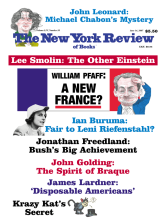In response to:
The House of Edith from the April 26, 2007 issue
To the Editors:
I read with interest Edmund White’s review of Hermione Lee’s biography Edith Wharton [NYR, April 26]. One mystery that has not been solved by Ms. Lee or any other scholar is, who influenced Wharton’s early artistic development? Why did Edith Wharton, descendant of New York’s “Four Hundred,” choose for her subject matter the lives of the struggling lower classes to portray American moral values?
As I was adapting Wharton’s novella Bunner Sisters (written in 1891, published in 1916) for the stage, I uncovered that missing link. I assumed, as well as everyone else, that Wharton made up the name Bunner. It turns out we were mistaken. The influence on the still young, unformed Wharton was H.C. Bunner, author, poet, playwright, and editor in chief of Puck Magazine, America’s first successful political comic weekly. He was the “literary light” of her era.
As a writer and member of the Authors Club, H.C. Bunner (1855–1896) was the first to bring to the forefront the radical concept of New York City as a creative resource, spelled out in his 1883 essay “New York as a Field for Fiction” in Century Magazine. He even laid out the format on how to write it. Bunner asked his fellow writers, “May we find a field for character-study in New York as Thackeray found in London and Augier in Paris? Must we not import our character, like our fashions, and our dressing-cases, and our wine?”
The quintessential New York writer, Bunner had already accepted the challenge he put forth to others by establishing this unique literary genre, “The New York Story,” in serial format each week in Puck and later in Scribner’s. During his lifetime, the public clamored for a Bunner sensibility, a Bunner style, and a Bunner point of view. His stories focused on the drama and hopes of the immigrant, the poor, and the new middle class as they attempted to carve out meaningful lives in the tenement houses of the city and its environs. Bunner recognized the importance and worth of this community. He used his magazine as a forum to integrate these individuals into the fabric of American life.
Edith Wharton’s novella Bunner Sisters is a testimony to him and his form. The story’s title, writing style, and genre reflect the actual lives of H.C. Bunner and his brother Rudolph. As Wharton herself wrote later in life, “I had yet no real personality of my own [in the early 1890s], and was not to acquire one till my first volume of short stories [The Great Inclination] was published—and that was not until 1899.”
Among Bunner’s devoted and admiring friends were literary giants Mark Twain, Robert Louis Stevenson, and W.D. Howells. He received an honorary degree of Master of Arts from Yale University (1895) and every year Columbia University awards a student the H.C. Bunner Gold Medal for the best essay written about American literature. Bunner’s brief life—died of tuberculosis at the age of forty-one—ought to be regarded as a tragic and untimely loss to American letters.
Linda Selman
New York City
Edmund White replies:
Edith Wharton may have been referring to H.C. Bunner in her choice of a title, Bunner Sisters, but it seems unlikely that his was the decisive influence on Mrs. Manstey’s View or Ethan Frome. In her early work she consistently revealed her strong ethical sense of the cost of riches and the underside of conspicuous consumption—and her sensitivity to these questions is a prominent (if underrated) aspect of that work.
This Issue
June 14, 2007



